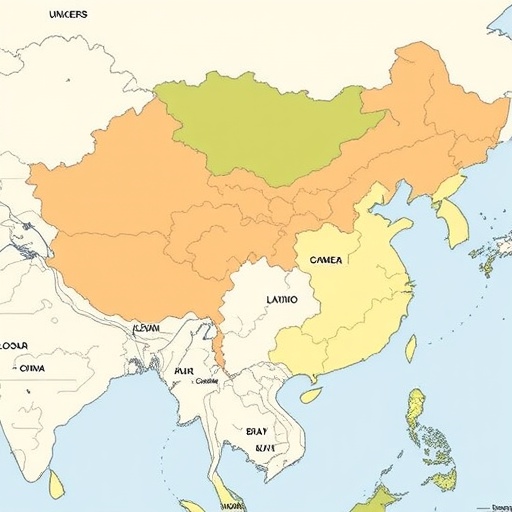In a groundbreaking study published in PLOS One, researchers from China have leveraged advanced machine learning algorithms to predict how climate change will reshape the geographical distribution of suitable habitats for tea cultivation across China’s four major tea-producing regions. As the world grapples with the multifaceted impacts of a warming planet, this research provides a scientifically rigorous projection of how one of the globe’s most economically and culturally significant crops may fare under future environmental conditions.
Tea production, integral to the livelihoods of millions and a vital component of both global trade and local traditions, is intricately linked to climatic variables such as temperature, precipitation, and humidity. The research team employed sophisticated AI-driven models to analyze decades of climate data alongside tea plant distribution records. Their results suggest not just an expansion in the overall land area suitable for growing tea but also a pronounced northward shift in optimal cultivation zones. This finding challenges earlier assumptions predicting a contraction of prime agricultural lands under climate stress.
Central to the study’s methodology was the integration of machine learning frameworks capable of handling complex, nonlinear interactions between multiple environmental factors. These models synthesized regional climate projections, soil characteristics, and topographical variation to generate high-resolution habitat suitability maps. Such precision enables stakeholders at various scales—from local farmers to national policymakers—to anticipate and adapt to changing agricultural landscapes with unprecedented clarity.
A paramount revelation from the analysis is the uneven impact of climate change across China’s diverse tea-producing provinces. While southern regions may face heightened heat stress and unpredictable rainfall, northern territories previously unsuitable for tea are becoming viable candidates for expansion. This shift could redefine regional economies, prompting changes in land use patterns and agricultural investment strategies. The authors emphasize the necessity for adaptive management strategies that align with these dynamic spatial trends.
The use of machine learning proved essential in capturing the nuanced, multidimensional dependencies influencing tea cultivation. Traditional models often rely on linear assumptions or limited variables, which can oversimplify the influences of climate variability. In contrast, the study’s AI models processed vast datasets, including satellite imagery and paleoclimate archives, uncovering subtle gradients of suitability that could otherwise be overlooked. This approach marks a significant advancement in agroecological forecasting.
Furthermore, the study underlines the role of climate change not only in shifting agricultural zones but also in altering phenological cycles of tea plants. The timing of flowering, leaf emergence, and harvest periods are all climate-dependent, influencing both yield quantity and quality. By anticipating these temporal adjustments, producers might optimize harvest schedules to maintain or improve tea output despite evolving environmental pressures.
The implications extend beyond China, offering a methodological blueprint for other tea-growing nations facing similar climatic uncertainties. As global demand for tea continues to rise, understanding future cultivation scenarios becomes critical for sustaining production and supporting rural economies. The adaptability afforded by AI-driven predictions could facilitate more resilient agricultural frameworks worldwide.
Moreover, the study acknowledges the socioeconomic dimensions tied to habitat shifts. Relocation or expansion of tea cultivation into new regions involves not only agronomic feasibility but also infrastructural readiness and community acceptance. Effective policy frameworks will therefore require interdisciplinary approaches integrating environmental science, economics, and social planning to ensure equitable transitions.
Importantly, the research received robust funding from prominent Chinese scientific bodies, reflecting national prioritization of sustainable agriculture in response to climate change challenges. The National Natural Science Foundation of China and regional agricultural initiatives backed this comprehensive effort, underscoring the strategic importance of tea as both a cultural artifact and an economic commodity.
The study also demonstrates the potential for artificial intelligence to transform agricultural research by enabling complex system modeling that was previously unattainable. Such tools empower scientists to deliver actionable insights that can shape future land management, inform breeding programs for climate-resilient tea varieties, and guide environmental conservation.
Lastly, the researchers declare no conflicts of interest, lending credibility and transparency to their findings. Their open-access publication facilitates broad dissemination, encouraging collaboration and innovation across the scientific community and agricultural sectors.
This pivotal research thus stands at the intersection of climate science, machine learning, and agronomy, offering a visionary outlook on how tea production in China will evolve in the coming decades. By harnessing artificial intelligence to anticipate environmental impacts, the study paves the way for proactive adaptation strategies that could safeguard one of the world’s most beloved beverages amid global change.
Subject of Research: Changes in suitable habitats for tea plants in China’s major tea-producing regions under climate change modeled using machine learning.
Article Title: Prediction of changes in suitable habitats for tea plants in China’s four major tea-producing regions based on machine learning models
News Publication Date: 8-Oct-2025
Web References: DOI Link
Image Credits: we-o_rd35roozacoybbg0c, Pixabay, CC0
Keywords: Climate change, tea cultivation, habitat suitability, machine learning, China, agricultural adaptation, AI modeling, environmental forecasting




